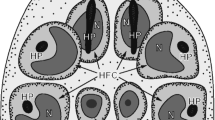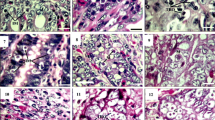Abstract
Six dogs were found to be susceptible to experimental infections with a European isolate ofEchinococcus multilocularis from southern Germany. Two cats were only poorly susceptible. Adult worms were not evenly distributed throughout the small intestine and the majority of parasites were found in the posterior region. The mode of attachment ofE. multilocularis in the dog was similar to that forE. granulosus with the adult worm extending its rostellum deep within a crypt of Lieberkühn. In cats only few worms were found to have penetrated deeply between the villi.E. multilocularis was found to possess a modified group of rostellar tegumental cells, morphologically and functionally identical to those described inE. granulosus and previously referred to as the “rostellar gland”. By studying development in vivo and in vitro, the time required for the production of shelled eggs was demonstrated to be only 28 days. Concurrent experimental infections in dogs withE. multilocularis andE. granulosus revealed that both species will develop together in the same host. Their development was not retarded in any way by the presence of the other and both species were able to coexist in the same area of the intestine.
Similar content being viewed by others
References
Ambo H, Ichikawa K, Iida H, Abe N (1954) On echinococcosis alveolaris, endemic parasitosis in Rebun Island (In Japanese). Spec Rep Hokkaido Inst Public Health 4:1–19
Crellin JR, Marchiondo AA, Andersen FL (1981) Comparison of suitability of dogs and cats as hosts ofEchinococcus multilocularis. Am J Vet Res 42:1980–1981
Eckert J, Müller B, Partridge AJ (1974) The domestic cat and dog as natural definitive hosts ofEchinococcus (Alveococcus) multilocularis in southern Federal Republic of Germany. Tropenmed Parasitol 25:334–337
Gamble WG, Segal M, Schantz PM, Rausch RL (1979) Alveolar hydatid disease in Minnesota. First human case acquired in the contiguous United States. J Am Vet Med Assoc 241:904–907
Kumaratilake LM, Thompson RCA, Dunsmore JD (1983) Comparative strobilar development ofEchinococcus granulosus of sheep origin from different geographical areas of Australia in vivo and in vitro. Int J Parasitol (in press)
Leiby PD, Kritsky DC (1972)Echinococcus multilocularis: A possible domestic life cycle in central north America and its public health implications. J Parasitol 58:1213–1215
Morsy TA, Michael SA, Disi AME (1980) Cats as reservoir hosts of human parasites in Amman, Jordan. J Egypt Soc Parasitol 10:5–18
Rausch RL (1967) On the ecology and distribution ofEchinococcus spp. (Cestoda: Taeniidae), and characteristics of their development in the intermediate host. Ann Parasitol Hum Comp 42:19–63
Rausch RL (1975) Taeniidae. In: Hubbert WT, McCulloch WF, Schnurrenberger RR (eds), Diseases transmitted from animals to man, Charles C Thomas, Springfield, p 678–707
Rausch RL, Richards SH (1971) Observations on parasite-host relationships ofEchinococcus multilocularis Leuckart, 1863, in North Dakota. Can J Zool 49:1317–1330
Rausch RL, Schiller EL (1956) Studies on the helminth fauna of Alaska. XXV. The ecology and public health significance ofEchinococcus sibiricensis Rausch & Schiller, 1954, on St. Lawrence Island. Parasitology 46:395–419
Smyth JD (1979)Echinococcus granulosus andE. multilocularis: in vitro culture of the strobilar stages from protoscoleces. Angew Parasitol 20:137–147
Smyth JD, Gemmell M, Smyth MM (1969) Establishment ofEchinococcus granulosus in the intestine of normal and vaccinated dogs. Ind J Helminthol, HD Srivastava Commen Vol:167–178
Smyth JD, Miller HJ, Howkins AB (1967) Further analysis of the factors controlling strobilisation, differentiation, and maturation ofEchinococcus granulosus in vitro. Exp Parasitol 21:31–41
Thompson RCA (1977) Growth, segmentation and maturation of the British horse and sheep strains ofEchinococcus granulosus in dogs. Int J Parasitol 7:281–285
Thompson RCA, Dunsmore JD, Hayton AR (1979)Echinococcus granulosus: secretory activity of the rostellum of the adult cestode in situ in the dog. Exp Parasitol 48:144–163
Thompson RCA, Eckert J (1982) The production of eggs byEchinococcus multilocularis in the laboratory following in vivo and in vitro development. Z Parasitenkd 68:227–234
Tscherner W (1978) A short prepatent period ofEchinococcus granulosus In: Proc 4th Int Cong Parasitol, Warszawa, 1978, Sect. Parasitic infections of economic and social importance, p 129
Vogel H (1957) Über denEchinococcus multilocularis Süddeutschlands. I. Das Bandwurmstadium von Stämmen menschlicher und tierischer Herkunft. Z Tropenmed Parasitol 8:404–454
Wobeser G (1971) The occurrence ofEchinococcus multilocularis (Leuckart, 1863) in cats near Saskatoon, Saskatchewan. Can Vet J 12:65–68
Yamashita J, Ohbayashi M, Kitamura Y (1958a) Studies on echinococcosis VII. On the development ofEchinococcus multilocularis in the tapeworm stage. Jap J Vet Res 6:89–91
Yamashita J, Ohbayashi M, Kitamura Y (1958b) Studies on echinococcosis IX. Differences in development of the tapeworm stage betweenEchinococcus granulosus (Batsch, 1786) andE. multilocularis Leuckart, 1863. Jap J Vet Res 6:226–229
Zeyhle E (1982a) Die Verbreitung vonEchinococcus multilocularis in Südwestdeutschland. In: Bähr R (ed). Probleme der Echinokokkose unter Berücksichtigung parasitologischer und klinischer Aspekte, Huber, Bern, pp 26–33
Zeyhle E (1982b) Distribution ofEchinococcus multilocularis in south and west Germany. Abstr. Fifth Int Congr Parasitol Toronto, 7–14 Aug 1982: p 258. Elsevier Amsterdam
Zeyhle E, Bosch D (1982) Comparative experimental infections of cats and foxes withEchinococcus multilocularis. Zbl Bakteriol 277; Abt Ref, p 117–118
Author information
Authors and Affiliations
Rights and permissions
About this article
Cite this article
Thompson, R.C.A., Eckert, J. Observations onEchinococcus multilocularis in the definitive host. Z. Parasitenkd. 69, 335–345 (1983). https://doi.org/10.1007/BF00927875
Accepted:
Issue Date:
DOI: https://doi.org/10.1007/BF00927875




